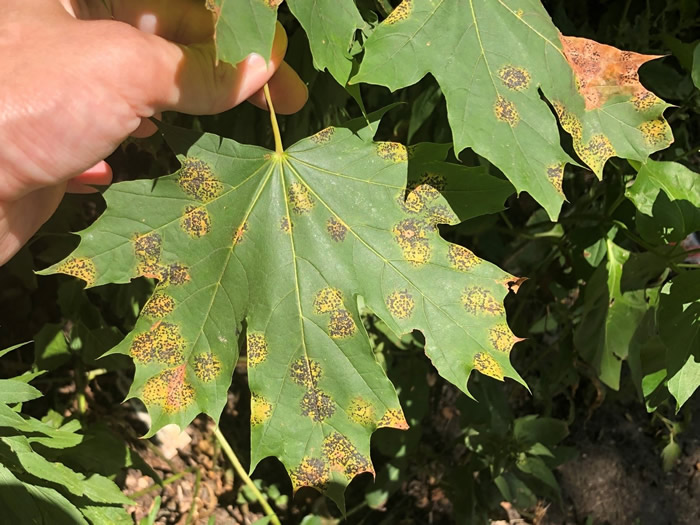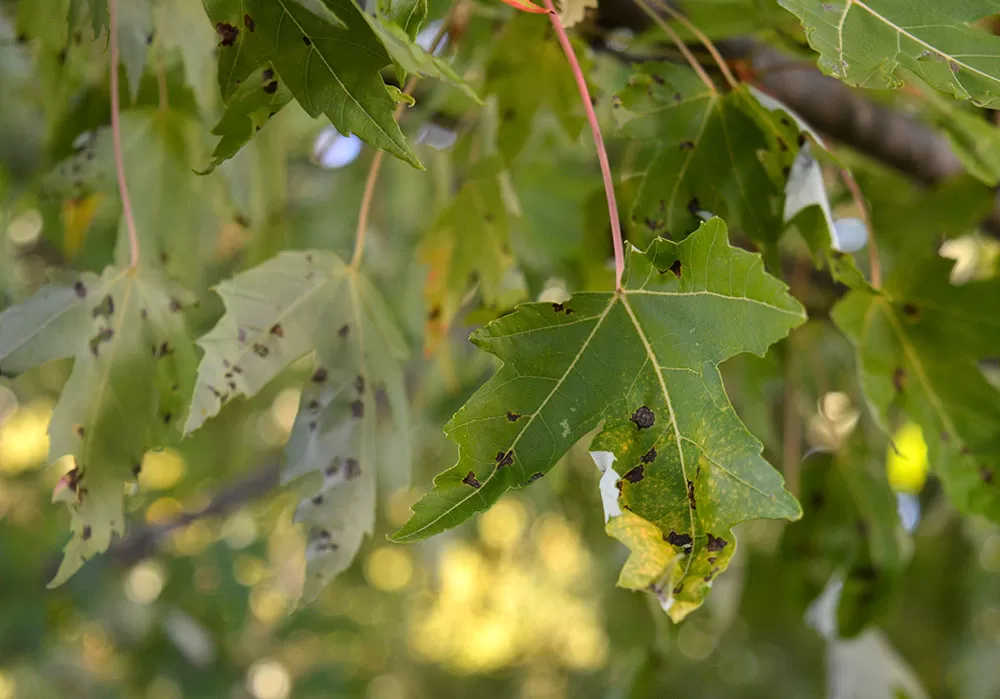black spots on tree leaves in illinois
The leaves on trees g rowing on poor sites or suffering from drought may also turn yellow and drop during August and September. Spots or blotches that are angular are generally referred to as anthracnose see entry on Anthracnose of Trees Leaves may yellow and drop prematurely.
Anthracnose Tar Spots On Trees City Of Blue Island
Black spots on oak leaves probably indicate a fungal problem.
. This allows the oak tree to photosynthesize and turn sunlight into energy for processing nutrients and moving water throughout the structure of the branches trunk and roots. Black spot disease is a fungus that mostly attacks fruit trees like the cherry tree walnut grapevine raspberry blackcurrant oak or red currant certain shrubs like hydrangea and also vegetables such as cucumber bean pea. This same canker and in some cases infected leaves will produce inoculum which then infects developing fruit from August through September.
Trees infected with maple leaf tar spot are unsightly but the fungal disease does not affect the overall health of the plants. Tar spot outbreaks are becoming more common and its distinct. Anthracnose Anthracnose fungus attacks hickory trees causing spots on their leaves.
You can also put them in the compost. Aphids typically are found on the underside of the leaves only. All are fungal diseases.
Black spot downy spot or white mold ink spot spot anthracnose leaf blister or curl scab shot-hole sooty blotch and tar spot. Septoria leaf spot occurs near the end of summer and is visible now in illinois. Black spots on the leaves indicate a serious health problem that affects the overall health and.
Unsightly black spots on maple leaves wont harm trees. The tree produces single white-light pink colored flowers on tiny shoots and a large fragrant pome fruit. Any thing within and under the canopy could also be sticky or have the black coating.
Usually tan dark brown yellow g ray purple or black. Leaf spot or anthracnose is caused by the fungus colletotrichum. In Illinois we may see three foliar diseases of dogwood.
The symptoms of tar spot will appear in mid-June as small pale yellow spots. Box elder Norway maple Oregon maple Red maple Silver maple Sugar maple Sycamore As with most tree fungi maple tar is more likely to happen if your area has been getting lots of rain. Its fine to wait for leaves to fall naturally.
Anthracnose can cause defoliation which reduces photosynthesis and the overall vigor of the tree. Removing live leaves from the tree would stress the maple if done too often more than once a year. Live oak leaves should be flat dark green and healthy.
It is more common in wet conditions or high humidity. Theyre all called tar spot and they most often affect. By mid-July the spots expand and a thick raised black stomata starts to form.
Symptoms include black spots on the foliage and fruit husks and shriveled nuts. They will grow optimally at average annual temperatures between 20 and 25C 6877F in a deep well draining loam and sandy loam with a pH between 50 and 55. Heavily infested trees may lose their leaves prematurely.
Some spots are raised shiny and coal black others may drop. Basic requirements Macadamia trees originate from the sub-tropical rainforests of Australia and therefore tend to grow best in areas of high humidity and high rainfall. Gather and burn all the leaves to eliminate any chance of having the fungus survive.
Leaf spot diseases weaken trees and shrubs by interrupting photosynthesis. Leaves that are infected with this fungal disease have round light green to yellowish-green areas approximately ½ to 1 inch in diameter that eventually blacken. The leaves have a smooth upper surface and hairy lower surface.
Another clue would be if leaves are sticky or shiny before the sooty mold develops. Septoria leaf spot spot anthracnose and Discula anthracnose. Identify the insect and then use an appropriate insecticide labeled for both the plant and the insect.
Is there a local organization that will come to our home to give us advice on what we need to do. Irregular dead spots on leaves Formation of cankers on twigs branches and the trunk Wilting and blackening of affected foliage Premature leaf drop Bud death resembling frost damage. All defoliation of black walnut trees is not due to leaf-spot diseases.
It impacts many trees but doesnt usually present any critical danger to them. Our mature Maple trees have black spots on the leaves and my concern is that we dont want to loose them if it is disease. Classic symptoms include numerous small spots on older cluster leaves with marked zones of lighter and darker tissues within the spots.
Leaf spot diseases should be taken seriously if they result in moderate to complete leaf loss two to four years in a row. Over time the spots may combine or enlarge to form blotches. The spots have irregular shapes and purplish coloring on the top of the leaves with brown coloring underneath.
Corn tar spot often appears as raised black spots on the upper and lower parts of the leaves and can have significant impact on yield. Black spot disease is diagnosed when black or brown spots appear on leaves. Affected leaves are always near dead or dying limbs that have a black rot canker on them.
The solution to eliminating black spots on maple. Fungal bodies may appear as black dots in the spots either in rings or in a central cluster. It can also lead to early dropping of leaves--this is most noticeable in August for the North and September for the South.
There are many reasons your trees leaves can turn black and fall off the tree. The following are some of the common symptoms indicating that your tree is infected. Severe cases may cause some premature defoliation.
The first two cause aesthetic problems but Discula anthracnose can kill branches and even entire trees. Symptoms Most leaf spot diseases develop as small scattered circ ular to oval dead areas in the leaves. Fortunately we do not see Discula anthracnose often in Illinois landscape settings.
If youre seeing spots on maple trees you are not alone. Essentially all around the lower half of Lake Michigan so the west and southern part of Michigan southern Wisconsin northern Illinois northern Indiana were severely affected with this disease Chilvers said. Fungal spores can overwinter.
Quince Cydonia oblonga is a bush-like deciduous tree in the family Rosaceae grown for its edible fruitsThe tree has crowded gnarled branches and a crooked growth habit. Stage Cristulariella moricola reported to occur only in southern Illinois and Ohio causes a bulls-eye or zonate leaf spot. Although not deadly to adult trees leaf spot does cause black spots to appear on the surface of leaves and may sometimes affect fruit as well.
Most leaf spot diseases affect only a small percentage of the trees overall leaf area and are a minor stress on the health of the tree. There are a couple types of fungi that cause those big brown or black spots on maple trees.

Treating Black Spots On Maple Leaves Naturally Prevention

Unsightly Black Spots On Maple Leaves Won T Harm Trees University Of Illinois Extension

Prevent Invasive Spread Of Oak Tree Fungus Chicago Tribune

Black Spots On Maple Leaves Here S What You Should Do

Treatment For Black Spots On Maple Tree Leaves Davey Blog

Black Spots On Maple Leaves Here S What You Should Do
Home Yard Garden Newsletter At The University Of Illinois
Anthracnose Tar Spots On Trees City Of Blue Island

Irregular Dark Patches On Leaves Could Be Fungal Anthracnose Chicago Tribune